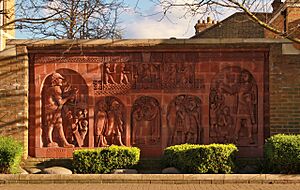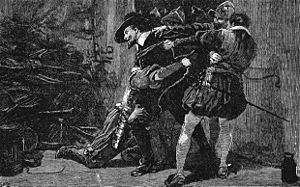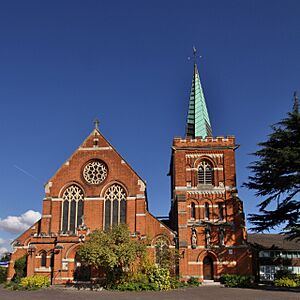History of Staines-upon-Thames facts for kids
The history of Staines-upon-Thames in Surrey, England, and historically in the county of Middlesex, is a long and interesting one. This town has seen many changes, from ancient settlements to Roman roads, royal events, and the growth of modern industries. Let's take a journey through time to discover the key moments that shaped Staines-upon-Thames.
Contents
Early Beginnings and Roman Times
- 3000 BC — People lived in the area around Staines even in the Stone Age! Evidence of a settlement has been found at Yeoveney Manor Farm, near Staines Moor.
- 43 AD — The Roman Empire built the first Staines Bridge. This was a very important crossing point over the River Thames for their roads.
- 1009 — A Danish army, led by Sweyn Forkbeard, crossed the river at Staines. They were trying to avoid an English army gathering in London. This shows how important the river crossing at Staines was.
Medieval Staines
- 1086 — The Domesday Book, which was a huge survey of England, mentioned Staines. It was called Stanes and was owned by Westminster Abbey. It had mills, weirs, and meadows, showing it was a busy place.
- 1215 — A very famous event happened nearby! Powerful barons and earls made King John agree to the Magna Carta at Runnymede, between Windsor and Staines. Some of the people involved even stayed in Staines before the signing.
- 1218 — Staines started having a regular market. The King ordered it to be held on Fridays. This market still runs today!
- 1222 — The Staines Bridge was mentioned again after Roman times. The King even gave wood from Windsor Great Park to help repair it.
- 1285 — The London Stone was placed in Staines. This stone marked the western edge of the City of London's control over the River Thames.
From Manors to Modern Industry
- 1603 — The famous writer and explorer, Sir Walter Raleigh, was brought before magistrates in Staines. He was later tried and imprisoned for being involved in a plot against the King.
- 1613 — The land around Staines, known as the manor, was given to Thomas Knyvet, 1st Baron Knyvet. He was famous for arresting Guy Fawkes during the Gunpowder Plot, which was a plan to blow up the Houses of Parliament. This event is still celebrated every year on Bonfire Night.
- 1618 — Money was collected in churches to help repair the Staines Bridge and its causeway (a raised road over wet ground).
- 1669 — The manor of Staines changed hands several times. It was eventually bought by Richard Tayler, and his family owned parts of it until 1890.
- 1725 — The Staines Bridge was rebuilt in stone, but it sadly collapsed almost right away!
Bridges, Railways, and New Ideas
- 1832 — The second stone version of Staines Bridge, which is the one we see today, was officially opened by King William IV.
- 1848 — A railway line opened, connecting Staines to London Waterloo. This made travel and trade much easier for the town.
- 1851 — The Staines Boat Club was started, showing the town's connection to the river.
- 1862 — The Staines Linoleum Company opened. This company made a new type of floor covering called Linoleum, invented by Frederick Walton.
- 1872 — The old market building was taken down to make way for a new Town Hall.
- 1890 — The Hockey Club was formed, making it one of the oldest hockey clubs in the world!
- 1892 — Staines Town Football Club was formed, originally called Staines Albany Football Club.
- 1894 — The Staines Urban District was created to manage the town's services.
- 1901 — The large Staines Reservoirs were built. These reservoirs helped provide clean drinking water for London.
- 1906 — The British car maker Lagonda was founded in Staines by Wilbur Gunn.
- 1908 — The first Scout Troop in Staines was formed.
- 1935 — A Lagonda car built in Staines won the famous 24 Hours of Le Mans car race!
Modern Staines and Beyond
- 1961 — The Runnymede Bridge was opened. This new bridge helped traffic bypass Staines, making journeys smoother for people travelling to the south-west of England.
- 1965 — Staines was officially moved from Middlesex to Surrey county.
- 1972 — A sad event occurred when a British European Airways jet airliner crashed near the Staines bypass, resulting in many lives lost.
- 1974 — Staines joined with Sunbury (on Thames) to form the Spelthorne Borough.
- 1980 — The Elmsleigh Centre, a shopping centre, was opened by Queen Elizabeth II.
- 1980 — The Spelthorne Museum was created in the Old Fire Station. It displays items found during building work in the 1970s.
- 1993 — The old Town Hall was turned into an Arts Centre, which was opened by actor Kenneth Branagh.
- 2002 — The character Ali G, played by Sacha Baron Cohen, became famous in the film Ali G Indahouse. Staines was his fictional hometown, and much of the movie was filmed there.
- 2012 — The town's official name was changed from Staines to Staines-upon-Thames. This change highlighted its important connection to the river.
Nearby Important Events
- 1886 — Royal Holloway, University of London was founded by Thomas Holloway and opened by Queen Victoria in nearby Egham.
- 1925 — The Queen Mary Reservoir was opened near Littleton.
- 1971 — The M4 motorway opened, making it easier to travel through Berkshire.
- 1974 — The M3 motorway opened through Surrey, further improving road travel.
- 1985 — The M25 motorway was opened. Parts of it near Staines are sometimes called "the Staines section."
See also

All content from Kiddle encyclopedia articles (including the article images and facts) can be freely used under Attribution-ShareAlike license, unless stated otherwise. Cite this article:
History of Staines-upon-Thames Facts for Kids. Kiddle Encyclopedia.




